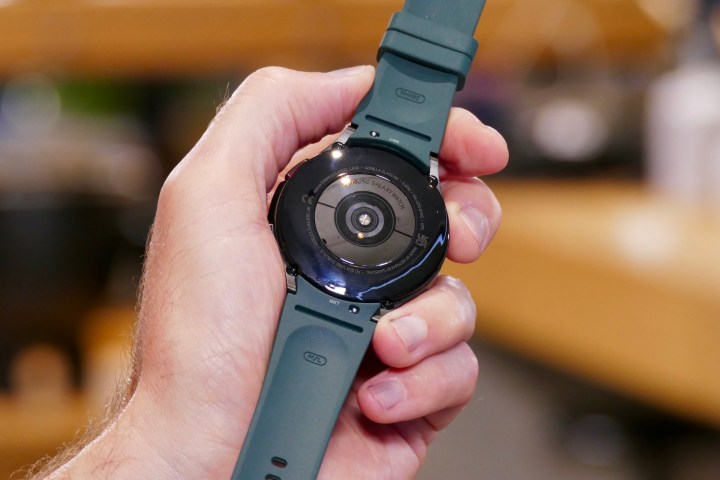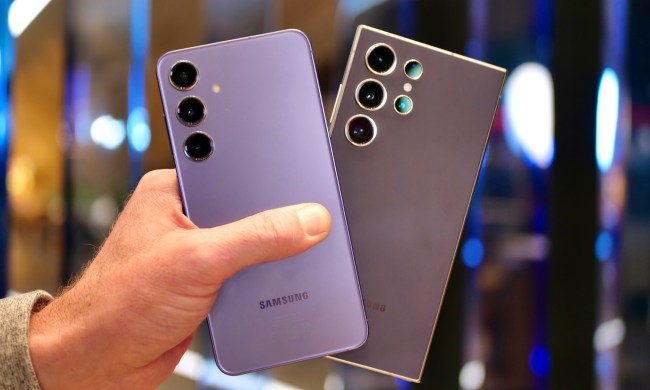As good as they are, you may have been left scratching your head by the Samsung Galaxy Watch 4 and Galaxy Watch 4 Classic. Normally, there are significant differences between different models in the same device range, but in this case, the differences are mostly cosmetic. The Watch 4 Classic retains the tried-and-true design of the Galaxy Watch 3, which, in contrast to most Apple Watches, more closely resembles a traditional watch. But the Galaxy Watch 4 goes for a sleeker, more modern look, which sits somewhere in the middle between its stablemate and something you might find on the Starship Enterprise.
However, there are a few more differences between the Galaxy Watch 4 and Galaxy Watch 4 Classic than how they look. We run through them in this head-to-head comparison article, and we also attempt to decide which is the better smartwatch overall.
Specs
| Samsung Galaxy Watch 4 |
Samsung Galaxy Watch 4 Classic | |
| Display size | 40mm: 1.2 inches
44mm: 1.4 inches |
42mm: 1.19 inches
46mm: 1.4 inches |
| Body size | 40mm: 40.4 x 39.3 x 9.8mm (1.59 x 1.55 x 0.39 inches)
44mm: 44.4 x 43.3 x 9.8mm (1.75 x 1.70 x 0.39 inches) |
42mm: 41.5 x 41.5 x 11.2mm (1.63 x 1.63 x 0.44 inches)
46mm: 45.5 x 45.5 x 11mm (1.79 x 1.79 x 0.43 inches) |
| Resolution | 40mm: 396 x 396 pixels (330 pixels per inch)
44mm: 450 x 450 pixels (330 ppi) |
42mm: 396 x 396 pixels (330 ppi)
46mm: 450 x 450 pixels (330 ppi) |
| Touchscreen |
40mm: 1.2-inch Super AMOLED touchscreen 44mm: 1.4-inch Super AMOLED touchscreen
|
42mm: 1.19-inch Super AMOLED capacitive touchscreen
46mm: 1.4-inch Super AMOLED capacitive touchscreen |
| Storage | 16GB | 16GB |
| Wireless interface | Bluetooth 5.0, Wi-Fi 802.11 a/b/g/n, NFC, LTE | Bluetooth 5.0, Wi-Fi 802.11 a/b/g/n, NFC, LTE |
| Depth | 9.8mm | 42mm: 11.2 mm
46mm: 11 mm |
| Blood oxygen sensor |
Yes | Yes |
| Accelerometer | Yes | Yes |
| Gyroscope | Yes | Yes |
| Ambient light sensor | Yes | Yes |
| Heart rate sensor | Yes | Yes |
| Barometer | Yes | Yes |
| GPS | Yes | Yes |
| Compass | Yes | No |
| Water-resistant | Yes | Yes |
| Battery life | Up to 40 hours (based on Samsung laboratory measurements) | Up to 40 hours (based on Samsung laboratory measurements) |
| Price | From $250 | From $350 |
| Availability | Samsung | Samsung |
| DT review | Hands-on | Hands-on |
Design and display

As noted above, the Samsung Galaxy Watch 4 and Galaxy Watch 4 Classic differentiate themselves through their designs. The Watch 4 Classic retains the rotating bezel around its display that gives it a slightly bulkier look but also provides a satisfying user experience. Meanwhile, the Watch 4 strips away the mechanical bezel for a digital alternative, something that allows it to look a little more streamlined and contemporary.
Which design you prefer is a matter of personal preference. However, it’s worth pointing out some more objective differences: The Watch 4 is a touch lighter and smaller than the Watch 4 Classic, something that again may be more preferable depending on your own needs and inclinations. The Watch 4 comes in 40mm and 44mm sizes, with both having a depth of 9.8mm and with each weighing 25.9 grams (0.92 ounces) and 30.3 grams (1.06 ounces), respectively. As for the Watch 4 Classic, it comes in 42mm or 46mm models, with the 42mm model having a depth of 11.2mm and the 46mm version reducing to 11mm. These also weigh in at 46.5 grams (1.62 ounces) and 52 grams (1.83 ounces), respectively, making them slightly — but just about noticeably — heavier than the Watch 4’s two models.
In practice, you’re not really going to care the Watch 4 Classic is a tad heavier, but people with larger arms may prefer the somewhat expanded size of the Classic. Either way, you’re going to get exactly the same display, regardless of whether you go for the Watch 4 or the Watch 4 Classic. Both boast a Super AMOLED display with 330 ppi, irrespective of the size you choose. In other words, things are going to look pretty sharp.
One final slight difference worth mentioning is that the Watch 4 has an aluminum frame, while the Watch 4 Classic has the option of either a steel or titanium casing. This would make the Classic a little more durable and arguably more luxurious. However, the difference is pretty minimal, so we’re calling this round a tie since the differences are so subjective.
Winner: Tie
Fitness and health-tracking features

Samsung has upped its health-tracking game with the Watch 4 and Watch 4 Classic. Both devices offer a range of sensors new to the Galaxy Watch series, including an optical heart rate sensor (8PD), an electrical heart sensor (ECG), and biological impedance analysis (BIA). These let you monitor such things as your sleep, your blood-oxygen level, your blood pressure, and also your body composition (i.e., your body fat levels). You also get the ability to track over 100 different workouts, making the Watch 4 and Watch 4 Classic seriously comprehensive.
As impressive as they are, both watches are identical as far as fitness- and health-tracking goes, while they also both feature WearOS 3 with Samsung’s own customizable OneUI interface over the top. As such, this round is another tie.
Winner: Tie
Battery life

This may not come as a surprise, but the Samsung Galaxy Watch 4 and the Galaxy Watch 4 Classic are identical in the battery department. If you opt for the 40mm Watch 4 or the 42mm Watch 4 Classic, you’ll have a 247mAh battery under your proverbial hood. If you go for the 44mm Watch 4 or the 46mm Classic, you’ll get 361mAh of capacity.
In practice, Samsung says these batteries will give you 40 hours of running (pun intended) time, although this will naturally vary according to how you use your watch. It’s possible that you can get the larger Watch 4 and Watch 4 Classic models to run longer if you use certain of their features more sparingly, but in general, their stamina should balance out with that of the smaller models, given their larger display sizes and more intensive requirements.
Again, this is another tie.
Winner: Tie
Special features

There’s really only one special feature to mention when it comes to the Samsung Galaxy Watch 4 and Watch 4 Classic. It’s that the Classic keeps the rotating bezel of previous models, while the Watch 4 gets rid of it. This makes the Classic more intuitive and enjoyable to use since the bezel allows for easier scrolling through menus and apps and helps you avoid having to tap or swipe the display (thereby risking smudges).
Still, the Watch 4 does include a digital rotating bezel, which simulates the functionality of the mechanical bezel but doesn’t feel quite as satisfying or robust. It does a good enough job, though, so we’re not going to mark it down too heavily, despite the fact that some may prefer the Classic simply for its inclusion of the mechanical bezel.
Otherwise, the features are exactly the same. As noted above, both watches run on WearOS 3 with OneUI as a skin. This provides a similarly smooth experience to what you can find on the Galaxy Watch 3 but with bolder graphics and icons. Given that WearOS 3 is a collaboration with Google, it will also give you access to apps such as Google Maps.
Winner: Tie
Price and availability
The Samsung Galaxy Watch 4 starts at $250 and is available to preorder from Samsung now. LTE versions are available for an extra $50, with the LTE version of the watch being supported by AT&T, T-Mobile, and Verizon. You’ll also find it being sold by most major retailers.
The Galaxy Watch 4 Classic begins from $350 and, as above, is available from Samsung to preorder. Its LTE version is also supported by all major carriers.
Overall winner: Samsung Galaxy Watch 4

We’re giving the overall victory to the Samsung Galaxy Watch 4, and for one main reason: It’s $100 cheaper than the Galaxy Watch 4 Classic. That’s right, for a savings of $100, you get basically the same smartwatch with the same health-and-fitness tracking features, the same battery, the same display, and the same software. The only difference is that the Watch 4 Classic comes with a mechanical rotating bezel that may be missed by some and that the Classic, as its name suggests, looks a little more traditional.
Despite the absence of a mechanical bezel, the Galaxy Watch 4 is every bit as good as the Watch 4 Classic, while some may also admire Samsung for going for a more modernist design this time. It’s a great watch and very much a worthy rival to the Apple Watch Series 6.



